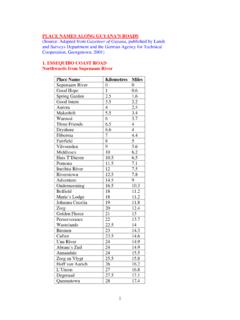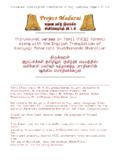Transcription of 41SNPAGE ji -- 111 I Ii11111 I I11111 lID! iii DIII11 ...
1 -- AD-A265. 111. IIi11111. I I11111 . lID! iii 41 SNPAGE. DIII11 . ! Ill. ji OMB ,o Approved ,"04 ,) 8. -- .. 1. AGE .. nttj 'UKI LArE 3 REPORT TYPE AND DATES COVERED. December 1992 TES/. 4. TITLE AND SUBTITLE S. FUNDING NUMBERS. "This Land is Ours!" The Shaping of XHOSA Resistance to European Expansion Along the Cape Colony's Eastern Frontier, 1770-1820. 6. AUTHOR(S). Robert S. Ehlers, Jr., 1st Lt 7. PERFORMING ORGANIZATION NAME(S) AND ADDRESS(ES) 8. PERFORMING ORGANIZATION. REPORT NUMBER. AFIT Student Attending:University of Florida AFIT/CI/CIA-92-127. 9. SPONSORING; MONITORING AGENCY NAME(S) AND AODRESS(ES) 10. SPONSORING MONITORING. AWNCY REPORT NUMBER. Wright-Patterson AFB OH 45433-6583. 11. SUPPLEMENTARY NOTES. 1Za. DISTRIBUTION AVAILABILITY STATEMENT 12b. DISTRIBUTION CODE. Approved for Public Release IAW 190-1. Distribution Unlimited ERNEST A.
2 HAYGOOD, Captain, USAF. Executive Officer 13. ABSTRACT (Maximu,, 200 words) D I %01 _. LEC. 93-12636. 14. SUBJECT TERMS 15. NUMBER OF PAGES. 137. 16. PRICE CODE. 17. SECURITY CLASSIFICATION 18. SECURITY CLASSIFICATION 19. SECURITY CLASSIFICATION 20. LIMITATION OF ABSTRACT. OF REPORT OF THIS PAGE OF ABSTRACT. NSN 7540-01-280-5500 Standard Form 298 (Rev 2-89). Prenr,bed bw AN4 Std Z39--I. Abstract of Thesis Presented to the Graduate School of the University of Florida in Partial Fulfillment of the Requirements for the Degree of Master of Arts "THIS LAND IS OURS!'. THE SHAPING OF XHOSA RESISTANCE TO EUROPEAN EXPANSION. ALONG THE CAPE COLONY'S EASTERN FRONTIER, 1770-1820. By Robert S. Ehlers, Jr. December 1992. Chairman: R. Hunt Davis, Jr. Major Department: History The purpose of this thesis is to illustrate how and to what degree internal conflict among the Xhosa polities of southern Africa and the relationships those polities main- tained with Europeans interacted to produce a firm aware- ness among the Xhosa that whites posed the major threat to their political and cultural autonomy.
3 With few exceptions, scholars of South African history have treated major wars between Xhosa and Europeans as defining moments in their relationship. This tendency to focus on warfare between the races has obscured the impor- tant conflicts that were constantly occurring among the Xhosa themselves, as well as the fact that significant peaceful interaction occurred between Xhoaa and European. Much of the existing literature also holds that the extreme hostility characteristic of later Xhosa-European relations was the rule from the earliest days of contact. In contrast to such work, this thesis will demonstrate that Xhosa perceptions of the European threat developed gradually. Thus, a long window of analysis, encompassing the period from 1770 to 1820, is necessary in order fully to understand the manner in which conflict among the Xhosa chiefdoms on the one hand and the relationships that those polities maintained with the Cape Colony on the other inter- acted to shape Xhosa attitudes towards whites.
4 This study addresses three distinct periods in the history of the Cape's Eastern Frontier. The first, covering the period before 1770, provides necessary background such as early Xhosa history and the physical geography of the region in which black and white made contact. The second period, running from 1770 to 1811, details early Xhosa- European interaction and the ways in which it influenced, and was influenced by, internal conflict among the Xhosa chiefdoms. The third and critical period covers the decade from 1811 to 1820, during which Xhosa attitudes towards whites underwent significant change. A complex interaction between internal and external stresses led during this decade to the most violent conflicts in Xhosa history, as well as to a clear idea among all the chiefdoms of the Accesion For danger posed by the Cape Colony. NTIS CRA&M. DTIC TAB.
5 Unannounced Justification .. r. -r"r " By ..- Dist, ibution I. Availability Codes Avail and Ior Dist Special Abstract of Thesis Presented to the Graduate School of the University of Florida in Partial Fulfillment of the Requirements for the Degree of Master of Arts "THIS LAND IS OURS!". THE SHAPING OF XHOSA RESISTANCE TO EUROPEAN EXPANSION. ALONG THE CAPE COLONY'S EASTERN FRONTIER, 1770-1820. By Robert S. Ehlers, Jr. December 1992. Chairman: R. Hunt Davis, Jr. Major Department: History The purpose of this thesis is to illustrate how and to what degree internal conflict among the Xhosa polities of southern Africa and the relationships those polities main- tained with Europeans interacted to produce a firm aware- ness among the Xhosa that whites posed the major threat to their political and cultural autonomy. With few exceptions, scholars of South African history have treated major wars between Xhosa and Europeans as defining moments in their relationship.
6 This tendency to focus on warfare between the races has obscured the impor- tant conflicts that were constantly occurring among the Xhosa themselves, as well as the fact that significant peaceful interaction occurred between Xhosa and European. Much of the existing literature also holds that the extreme hostility characteristic of later Xhosa-European relations was the rule from the earliest days of contact. In contrast to such work, this thesis will demonstrate that Xhosa perceptions of the European threat developed gradually. Thus, a long window of analysis, encompassing the period from 1770 to 1820, is necessary in order fully to understand the manner in which conflict among the Xhosa chiefdoms on the one hand and the relationships that those polities maintained with the Cape Colony on the other inter- acted to shape Xhosa attitudes towards whites.
7 This study addresses three distinct periods in the history of the Cape's Eastern Frontier. The first, covering the period before 1770, provides necessary background such as early Xhosa history and the physical geography of the region in which black and white made contact. The second period, running from 1770 to 1811, details early Xhosa- European interaction and the ways in which it influenced, and was influenced by, internal conflict among the Xhosa chiefdoms. The third and critical period covers the decade from 1811 to 1820, during which Xhosa attitudes towards whites underwent significant change. A complex interaction between internal and external stresses led during this decade to the most violent conflicts in Xhosa history, as well as to a clear idea among all the chiefdoms of the danger posed by the Cape Colony. "THIS LAND IS OURS!". THE SHAPING OF XHOSA RESISTANCE TO EUROPEAN EXPANSION.
8 ALONG THE CAPE COLONY'S EASTERN FRONTIER, 1770-1820. By ROBERT S. EHLERS, JR. A THESIS PRESENTED TO THE GRADUATE SCHOOL. OF THE UNIVERSITY OF FLORIDA IN PARTIAL FULFILLMENT. OF THE REQUIREMENTS FOR THE DEGREE OF. MASTER OF ARTS. UNIVERSITY OF FLORIDA. 1992. ACKNOWLEDGMENTS. I wish to thank the members of my graduate advisory committee for all of their assistance with this project. Professors Hunt Davis and John Mason provided many useful comments about the content of the work, as well as construc- tive suggestions for change. Professor Abraham Goldman's insights on geographical factors proved invaluable on sev- eral occasions. Also, I would like to stress my gratitude to Professor Steven Feierman and to my fellow graduate students for their constructive criticism of the thesis. Finally, and most of all, I want to thank my family: my mother and father, for instilling in me a love of history, as well as the discipline necessary for completing such a work; and my wife, Leisa, and daughter, Emily, whose patience, support and understanding allowed me successfully to undertake this venture.
9 Ii TABLE OF CONTENTS. Page ACKNOWLEDGMENTS .. ii LIST OF FIGURES .. v KEY TO ABBREVIATIONS .. vi ABSTRACT .. vii CHAPTERS. 1 INTRODUCTION .. 1. Purpose and Major Themes .. 1. Key Questions and Organization .. 3. Weaknesses in the Existing Historiography .. 5. The Nature of the Sources ..10. Issues of Sovereignty and Xhosa Identity .. 12. The Khoikhoi Experience .. 15. 2 THE BACKGROUND: GEOGRAPHY, XHOSA SOCIETY AND. XHOSA HISTORY TO 1770 .. 17. Physical Geography of the Frontier Zone .. 17. Xhosa Society and Settlement Patterns .. 21. History of the Xhosa to 1770 .. 27. 3 INTERACTION ON THE OPEN FRONTIER, 1770-1811 .. 32. The Nature of the Frontier .. 32. Xhosa-European Relations, 1770-1811 .. 36. The Significance of the Early Period .. 66. 4 THE CRUCIAL DECADE: RELATIONS FROM 73. The Nature of British Rule .. 73. Expulsion from the Fish-Sundays Region.
10 75. The Expulsion in Perspective .. 81. Xhosa-Colonial Relations, 1812-1817 .. 84. Increasing Conflict among the Xhosa, 93. Amalinde and the Fifth Frontier War, 103. The Significance of the Crucial Decade .. 118. iii 5 CONCLUSION: THE HARDENING OF XHOSA 121. Bitterness and War, 1820-1834 .. 121. A Brief Recapitulation .. 125. BIBLIOGRAPHY .. 129. BIOGRAPHICAL SKETCH .. 138. iv LIST OF FIGURES. Pacte Figure 2-1. The Mbashe-Sundays Region .. 18. Figure 3-1. The Cape's Eastern Frontier, 1800 .. 37. Figure 4-1. The Zuurveld, 1811-1820 .. 77. Figure 4-2. Amalinde, Grahamstown and the Eastern Frontier .. 106. Figure 4-3. Territorial Losses, 1811-1819 .. 117. v KEY TO ABBREVIATIONS. ABCO Report of the Select Committee on Aborigines, Parliamentary Paper 538 of 1836. CTG/AA Cage Town Gazette, and African Advertiser PP50 Papers relative to the condition and treatment of the native inhabitants of Southern Africa, Parliamentary Paper 50 of 1835.















